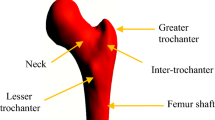Abstract
Finite element modeling (FEM) is a computational structural engineering technique that has been utilized to analyze the relationship between loads, various stresses, and deformation induced in bone and to design patient-specific orthopedic implants. For instance, the latest advances in FE model generation enhanced graphics in computer tomography and better segmentation techniques, increased the FEM precision, and developed the patient-specific simulated anatomies and the other mechanical and physical properties that are useful for orthopedic professionals. Three-dimensional (3D) model of the femur bone is extracted from Digital Imaging and Communications in Medicine (DICOM) images using MIMICS-21 software and further post-processing and analysis is done using ANSYS 18 version. The present study gives a comparative analysis of the FEM of the femur bone and the significant physiological variations in the femoral bone. The stress generation and total deformation of the healthy femur bone have been determined based on sex, age, and bodyweights from real-time data. The findings conclude that, in the case of females, the maximum bone strength and bone wall thickness are offered in 30–40 years age group and in the case of the male 40–50 years age group.
Access this chapter
Tax calculation will be finalised at checkout
Purchases are for personal use only
Similar content being viewed by others
References
Ethier CR, Simmons CA (2007) Introductory biomechanics: from cells to organisms. Cambridge University Press
Fantoni I, Lozano R, Sinha SC (2002) Non-linear control for underactuated mechanical systems. Appl Mech Rev 55(4):B67–B68
Petit MA, Beck TJ, Shults J, Zemel BS, Foster BJ, Leonard MB (2005) Proximal femur bone geometry is appropriately adapted to lean mass in overweight children and adolescents. Bone 36(3):568–576
Karwowski W, Ostaszewski K, Zurada JM (1992) Applications of catastrophe theory in modeling the risk of low back injury in manual lifting tasks. Le Travail Humain 259–275
Lombardi RM (2012) Bone density as a source of error measuring body composition with the BOD POD and iDXA in female runners (Doctoral dissertation, The Ohio State University)
Trabelsi N, Yosibash Z, Wutte C, Augat P, Eberle S (2011) Patient-specific finite element analysis of the human femur—a double-blinded biomechanical validation. J Biomech 44(9):1666–1672
Poelert S, Valstar E, Weinans H, Zadpoor AA (2013) Patient-specific finite element modeling of bones. Proc Inst Mech Eng [H] 227(4):464–478
Engelke K, van Rietbergen B, Zysset P (2016) FEA to measure bone strength: a review. Clin Rev Bone Miner Metab 14(1):26–37
Taylor CA, Hughes TJ, Zarins CK (1998) Finite element modeling of blood flow in arteries. Comput Methods Appl Mech Eng 158(1–2):155–196
Van den Broeck J, Vereecke E, Wirix-Speetjens R, Vander Sloten J (2014) Segmentation accuracy of long bones. Med Eng Phys 36(7):949–953
San Antonio T, Ciaccia M, Müller-Karger C, Casanova E (2012) Orientation of orthotropic material properties in a femur FE model: a method based on the principal stresses directions. Med Eng Phys 34(7):914–919
Lotz JC, Cheal EJ, Hayes WC (1995) Stress distributions within the proximal femur during gait and falls: implications for osteoporotic fracture. Osteoporos Int 5(4):252–261
Pianykh OS (2009) Digital imaging and communications in medicine (DICOM): a practical introduction and survival guide. Springer Science & Business Media
Lee DC, Hoffmann PF, Kopperdahl DL, Keaveny TM (2017) Phantomless calibration of CT scans for measurement of BMD and bone strength—inter-operator reanalysis precision. Bone 103:325–333
Gargiulo P (2011) 3D modeling and monitoring of denervated muscle under Functional Electrical Stimulation treatment and associated bone structural change. Eur J Transl Myol-Basic Appl Myol 21:31–94
Walter DJ, Sirinterlikci A (2017) Utilization of freeware and low cost tools in a rapid prototy** and reverse engineering course. In: ASEE Annual Conference Exposition. Columbus, USA
Hsu CE, Shih CM, Wang CC, Huang KC (2013) Lateral femoral wall thickness: a reliable predictor of post-operative lateral wall fracture in intertrochanteric fractures. Bone Joint J 95(8):1134–1138
Chen X, Liu Y (2018) Finite element modeling and simulation with ANSYS Workbench. CRC press
Yassine RA, Elham MK, Mustapha S, Hamade RF (2017) A detailed methodology for FEM analysis of long bones from CT using Mimics. In: ASME 2017 international mechanical engineering congress and exposition. American Society of Mechanical Engineers Digital Collection
Stolarski T, Nakasone Y, Yoshimoto S (2018) Engineering analysis with ANSYS software. Butterworth-Heinemann
da Silva GA, Beck AT, Sigmund O (2019) Stress-constrained topology optimization considering uniform manufacturing uncertainties. Comput Methods Appl Mech Eng 344:512–537
Madenci E, Guven I (2015) The finite element method and applications in engineering using ANSYS®. Springer
Saibene F, Minetti AE (2003) Biomechanical and physiological aspects of legged locomotion in humans. Eur J Appl Physiol 88(4):297–316
McKibbin B (1978) The biology of fracture healing in long bones. J Bone Joint Surg Br 60(2):150–162
Keyak JH, Sigurdsson S, Karlsdottir G, Oskarsdottir D, Sigmarsdottir A, Zhao S, Kornak J, Harris TB, Sigurdsson G, Jonsson BY, Siggeirsdottir K (2011) Male–female differences in the association between incident hip fracture and proximal femoral strength: a finite element analysis study. Bone 48(6):1239–1245
Doblaré M, Garcıa JM, Gómez MJ (2004) Modeling bone tissue fracture and healing: a review. Eng Fract Mech 71(13–14):1809–1840
Mccreadie BR, Goldstein SA (2000) Biomechanics of fracture: is bone mineral density sufficient to assess risk? J Bone Miner Res 15(12):2305–2308
Author information
Authors and Affiliations
Corresponding author
Editor information
Editors and Affiliations
Rights and permissions
Copyright information
© 2022 The Author(s), under exclusive license to Springer Nature Singapore Pte Ltd.
About this paper
Cite this paper
Yadav, D., Garg, R.K. (2022). Comparative Analysis of Mechanical Behavior of Femur Bone of Different Age and Sex Using FEA. In: Singari, R.M., Kankar, P.K., Moona, G. (eds) Advances in Mechanical Engineering and Technology. Lecture Notes in Mechanical Engineering. Springer, Singapore. https://doi.org/10.1007/978-981-16-9613-8_3
Download citation
DOI: https://doi.org/10.1007/978-981-16-9613-8_3
Published:
Publisher Name: Springer, Singapore
Print ISBN: 978-981-16-9612-1
Online ISBN: 978-981-16-9613-8
eBook Packages: EngineeringEngineering (R0)




